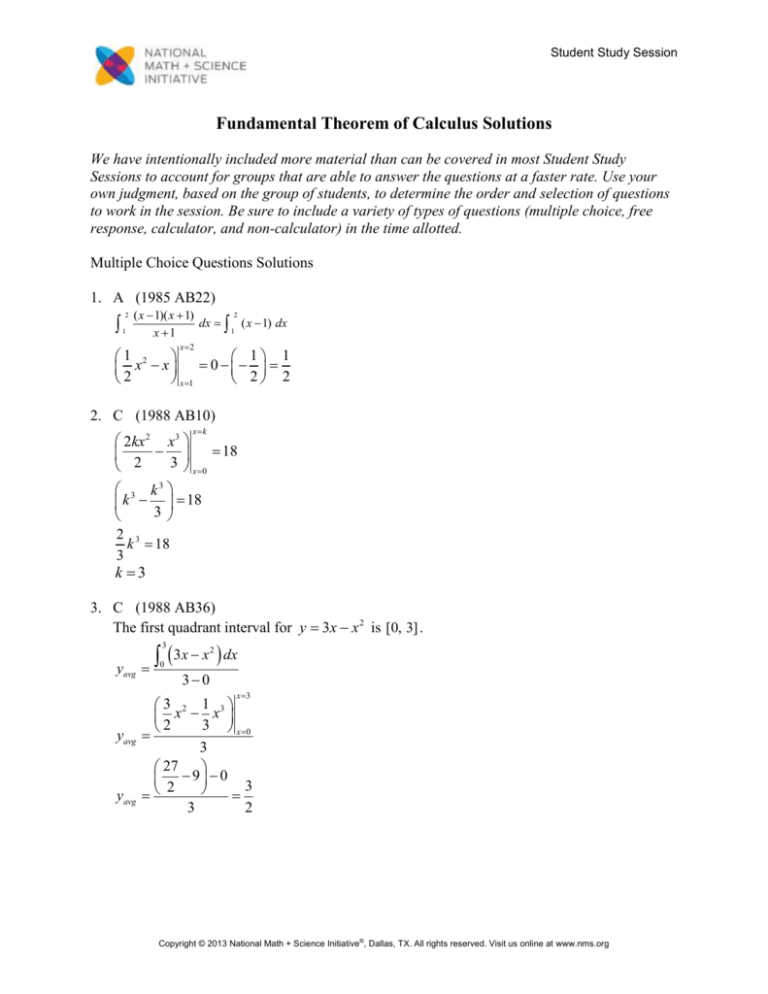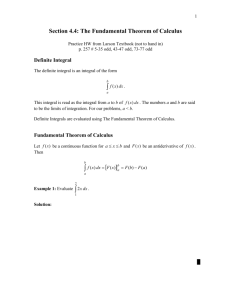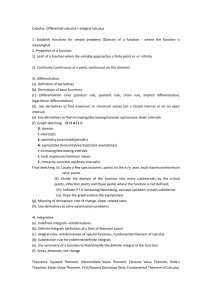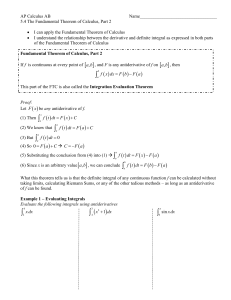
Student Study Session
Fundamental Theorem of Calculus Solutions
We have intentionally included more material than can be covered in most Student Study
Sessions to account for groups that are able to answer the questions at a faster rate. Use your
own judgment, based on the group of students, to determine the order and selection of questions
to work in the session. Be sure to include a variety of types of questions (multiple choice, free
response, calculator, and non-calculator) in the time allotted.
Multiple Choice Questions Solutions
1. A (1985 AB22)
2
1
2
( x 1)( x 1)
dx ( x 1) dx
1
x 1
x2
1 2
1 1
x x 0
2
x 1
2 2
2. C (1988 AB10)
xk
2kx 2 x3
18
3 x 0
2
3 k3
k 18
3
2 3
k 18
3
k 3
3. C (1988 AB36)
The first quadrant interval for y 3x x 2 is [0, 3] .
3x x dx
3
yavg
2
0
30
x 3
yavg
yavg
3 2 1 3
x x
3 x 0
2
3
27
9 0 3
2
3
2
Copyright © 2013 National Math + Science Initiative®, Dallas, TX. All rights reserved. Visit us online at www.nms.org
Fundamental Theorem of Calculus
Student Study Session
4. A (1988 AB13)
Using the Fundamental Theorem of Calculus,
c
0
b
a
f ( x)dx f (b) f (a) , it follows directly that
f ( x) dx f (c) f (0) .
5. D (2003 AB22)
1
f (1) f (0) f ( x) dx 5 3 8
0
Alternatively, the equation for the derivative shown is f ( x) 6 x 6 .
f ( x) ( 6 x 6) dx
f ( x) 3x 2 6 x c
With f (0) 5 implies c 5 and therefore f (1) 3 1 6(1) 5 8
2
6. E (2003 AB23)
Applying the Second Fundamental Theorem,
d g ( x)
f (t )dt f ( g ( x)) g ( x)
dx a
d x2
sin(t 3 )dt sin( x 2 )3 (2 x) 2 x sin( x 6 )
0
dx
7. C (1993 BC41 appropriate for AB)
2
2
d x 2 3 x t 2
f ( x)
e dt e( x 3 x ) (2 x 3)
dx 2
3
f ( x) 0 only when x .
2
3
3
3
f 0 for , and f 0 for , thus f ( x ) has a minimum at x .
2
2
2
8. D (1988 AB14)
cos
02 1 sin d
Let u 1 sin
2
1
1
2
u du 2u
1 u 2
2
2 2 (2)
u 1
9. C (2003 BC18 appropriate for AB)
d 2x
g ( x)
f (t ) dt 2 f (2 x)
dx 0
g (3) 2 f (2 3) 2 f (6) 2( 1) 2
10. E (1993 BC3 appropriate for AB)
Q( x) p( x) , so the degree of Q is n 1.
Copyright © 2013 National Math + Science Initiative®, Dallas, TX. All rights reserved. Visit us online at www.nms.org
Fundamental Theorem of Calculus
Student Study Session
11. E (1973 BC45 appropriate for AB)
F ( x) xg ( x) with x 0 and g ( x) 0 , so F ( x) 0 ; therefore, F is decreasing (not
increasing).
12. E (2003 AB19)
d x3
2
0 ln t 1 dt
dx
2
3 2
(3 x ) ln ( x ) 1
(3 x 2 ) ln x 6 1
13. B (1988 AB19)
u x2 1
du 2xdx
x 2 u 22 1 5 and x 3 u 32 1 10 , so
1 10 1
du
2 5 u
1
(ln10 ln 5)
2
1 10
ln
2 5
1
ln 2
2
14. D (2003 AB92)
g ( x ) is decreasing when g ( x) 0 .
d x
g ( x)
sin(t 2 )dt
0
dx
g ( x) sin( x 2 )
Using a graphing calculator, determine where g ( x) 0 .
1.772 x 2.507
15. B (1997 BC82 appropriate for AB)
x
x
1
1
Since (t 2 2t ) dt t dt , x3 x 2 x 2 2 . Using the calculator, the greatest x-value
0
2
3
2
on the interval [0, 4] that satisfies this inequality is found to occur at x 1.3887 .
16. E (1997 AB88)
x
f ( x) h( x)dx , so f (a ) 0 ; therefore, only choices (A) and (E) are possible. But
a
f ( x) h( x) , so f is differentiable at x b . This is true for the graph in option (E), but not
for the graph in option (A), where there appears to be a sharp turn at x b . Also, since h is
increasing at first, the graph of f must start out concave up. This is also true in (E) but not (A).
Copyright © 2013 National Math + Science Initiative®, Dallas, TX. All rights reserved. Visit us online at www.nms.org
Fundamental Theorem of Calculus
Student Study Session
17. A
(2008 BC88 appropriate for AB)
x
2
2
2
g ( x) f (t )dt and f 0 and f 0 ; g ( x) f ( x) , so g ( x) f ( x) . g (2) f (t ) dt 0 .
Since f 0, g 0 , so g is increasing, so f (1) g (2) , so g (1) 2 . f 0 , so g 0 , so g
g (3) g (2) g (2) g (1)
is decreasing; therefore,
, so the answer is choice A.
3 2
2 1
18. A
(2003 AB82)
The function r (t ) is the rate of change in the altitude, so the altitude is decreasing when
r (t ) 0 . The zeros of r (t ) are 1.572 and 3.514, so the change in altitude when the altitude is
decreasing can be found using
19. A
1.572 r t dt .
3.514
(2003 AB84)
5
T (5) T (0) (110e0.4t ) dt 350 237.78 112 F
0
20. A
(2003 BC80 appropriate for AB)
0.1t
14 100e
T
dt 124.499 125 tons
7 2 e 3t
Copyright © 2013 National Math + Science Initiative®, Dallas, TX. All rights reserved. Visit us online at www.nms.org
Fundamental Theorem of Calculus
Student Study Session
Free Response Questions
21. 2010 AB1/BC1acd
(a)
f t dt 142.274 or 142.275 cubic feet
6
0
2
(c) h 0 0
1: h t for 0 t 6
For 0 t 6 ,
h t h 0 g s ds 0 0 ds 0
For 6 t 7 ,
1: integral
1: answer
t
t
0
0
3 1: h t for 6 t 7
1: h t for 7 t 9
h t h 6 g s ds 0 125 ds 125 t 6
For 7 t 9 ,
t
t
6
6
h t h 7 g s ds 125 108 ds 125 108 t 7
t
t
7
7
0;
0t 6
Thus, h t 125(t 6);
6t 7
125 108 t 7 ; 7 t 9
(d) Amount of snow is
f t dt h 9 26.334 or 26.335
9
0
cubic feet.
1: integral
3 1: h 9
1: answer
22. 2009 AB2/BC2acd
(a)
R t dt 980 people
2
2
0
(c) w 2 w 1 w t dt 2 t R t dt 387.5
2
1
2
1
The total wait time for those who enter the auditorium
after time t 1 is 387.5 hours.
(d)
1: integral
1: answer
1
1 2
w 2
2 t R t dt 0.77551
980
980 0
On average, a person waits 0.775 or 0.776 hour.
1: integral
2 1: answer
2
1: integral
1: answer
Copyright © 2013 National Math + Science Initiative®, Dallas, TX. All rights reserved. Visit us online at www.nms.org
Fundamental Theorem of Calculus
Student Study Session
23. 2009 AB5/BC5b
(b)
3 5 f x dx
13
13
2
2
1: uses Fundamental
Theorem of Calculus
2
1: answer
3 dx 5 f x dx
13
2
313 2 5 f 13 f 2 8
24. 2010 AB5a
(a) g 3 5 g x dx 5
3
22
0
4
3 13
2 2
2
g 2 5 g x dx 5
1: uses g 0 5
3 1: g 3
0
1: g 2
25. 2008B AB4
(a)
f x 3 4 3x
2
4
g x f sin x cos x
2:
f x
2: g x
3 4 3sin x cos x
(c)
2
For 0 x , g ( x) 0 only at x
g 0 g 0
1: sets g x 0
.
2
1: justifies maximum at
3
3
g 4 t 2 dt 0
2 0
The maximum value of g on 0, is
3
0
2
1: integral expression for g
2
4 t 2 dt .
Copyright © 2013 National Math + Science Initiative®, Dallas, TX. All rights reserved. Visit us online at www.nms.org
Fundamental Theorem of Calculus
Student Study Session
26. 2009B AB1ac
1: integral
3 1: expression for R t
1: R 3
1
3 sin x 2 dx
16
R(3) 6.610 or 6.611
(a) R t 6
t
0
(c)
A t dt A3 A 0 24.200 or 24.201
3
0
From time t 0 to t 3 years, the cross-sectional
area grows by 24.201 square centimeters.
1: uses Fundamental
Theorem of Calculus
3 1: value of 3 A t dt
0
1: meaning of A t dt
3
0
27. 2011B AB6
(a)
4
2
x
g x cos dx
2
2
f x dx
4
x 4
x
6 2sin
2 x2
2
6
1: antiderivative
2
1: answer
2
(c) h x g 3x 3
h 3g 3
3
2: h x
3
1: answer
Copyright © 2013 National Math + Science Initiative®, Dallas, TX. All rights reserved. Visit us online at www.nms.org








